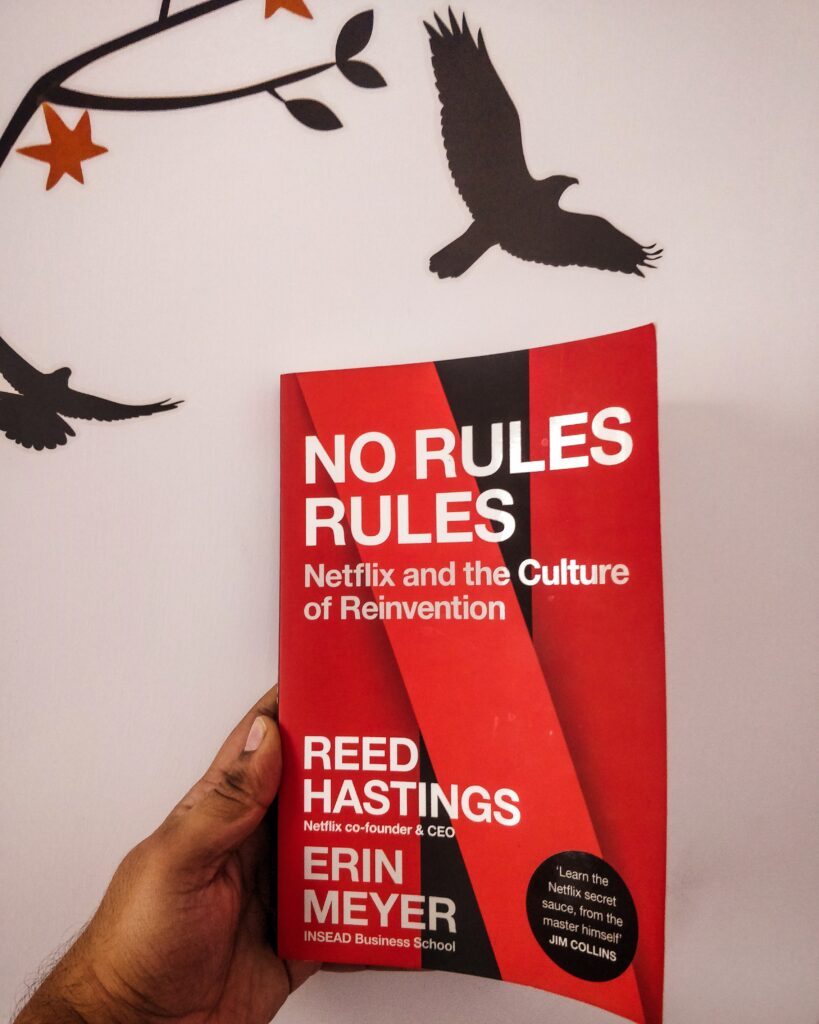No Rules Rules- Netflix and the culture of Reinvention.

First, I love the fact as to how apt the title is to this book. Being a book that revolves around the concept of not having too many rules at a workplace, the title fits just right.
No Rules Rules, co-written by Netflix founder and CEO- Reed Hastings and author Erin Meyer, is an intriguing read about company culture. It focuses on highlighting the culture at Netflix and how Reed feels that it has been essential for the global growth that they’ve witnessed.
The culture at Netflix is about letting go of any form of control. It is about leading with context instead of control. The expectation, top-down, is about how you can let people make their own decisions and own up to any success or failure of it. Whether it’s the CEO or an associate, their decisions are their own.
Throughout the book, you get to read interesting incidents that highlight how Netflix has been able to build this culture. For instance, on the cusp of House of Cards’ new season releasing, Netflix had decided to partner up with Samsung to let viewers watch the show on 4K ultra high definition TV. To do this, they needed to get this experience to be reviewed by a Washington Post journalist Geoffrey Fowler. Before sending the TV to the journalist, the day before the actual release, they tested the TV and went home. Now, for some reason, the TV was disposed of along with other old TVs in their office. So, instead of it going for the review, Nigel (Director responsible to get this done) was left incessantly calling nearby stores for the TV. But, he had no luck. He was panicking and felt like he’d failed. And then, a junior engineer Nick walks in and assures that the TV has been sent as required. This, because when Nick walked in the early morning he realized what had happened and immediately drove to a best buy and bought a TV worth 2.5k USD. He did that because he felt that was the right thing to do. He saved the day for his team by making a decision without waiting for an approval from his superiors. Netflix is known for similar instances of a no-approval-required policy. The concept of F&R (Freedom and responsibility) is what drives the culture at the company.
While the goal of Netflix has been to ‘Lead with Context and not with Control’, the book highlights the steps that have led them here.
As a reader, your mind immediately wanders to the question, ‘Can this be applied to ALL workplaces?’, ‘Is this specific to a US-centric work culture?’, ‘Not ALL workplaces can function without a degree of control, right?’. And the book tries its best to answer most of the questions.
The book is a good read if you are in a position where you assert a degree of control as a manager or supervisor. It brings a new perspective on possibly letting go of control. At the start, you’re on board with the concept, but as you read on, you realize not everything can be globally adopted. Not all cultures are the same and there would have to be an acceptance for contrasting culture/personality types to come to a middle path.
The book highlights how Netflix focussed on increasing its talent density and let go of anyone who wasn’t the best. ‘Adequate performance deserves a generous severance package’ is what Reed instilled as a practice. This meant anyone who wasn’t performing at their very best was fired. This came as a follow-up realization when they had to fire people at one time but the best-of-the-best who remained got the job done. At Netflix, everyone- the managers as well as the reports- has to take a Keeper’s Test. The test asks a manager how hard he’ll fight to keep an employee in the team. Individuals are also advised to ask their managers, this exact question to ascertain whether their managers are happy with them or not.
One of the other highlights of Netflix’s culture is actively seeking feedback. This applies and goes both ways. Employees are encouraged to provide feedback to their peers as well as managers. The feedback has to be actionable and should align with the concept of 4As. While giving feedback, Aim to assist and make it actionable and when you receive it, appreciate it and then make a decision whether you want to accept it or discard it. Later on, the book also talks about a 5th A- To Adapt.
A range of case studies, failures along the way to establish a culture, and learnings from a variety of people issues form the core of this book. It is definitely a page-turner and at no point do you feel like not reading what the people of Netflix have to say. It is, like the concept popularized by Netflix- binge-worthy!
Worth a read for those who’re trying to understand how cultures shape global organizations and the need to adapt.
Leave a Reply